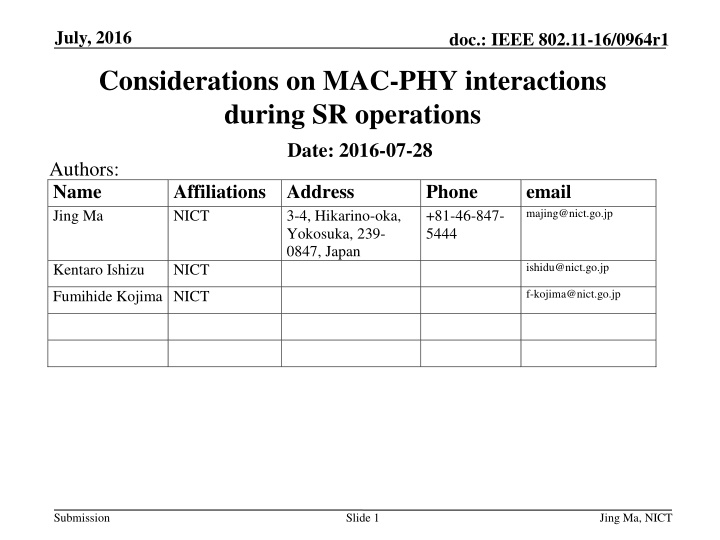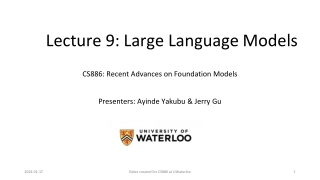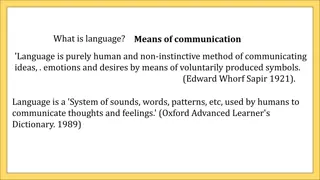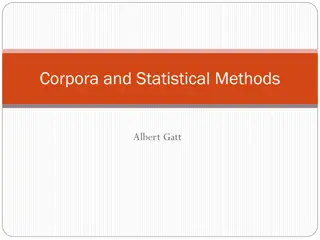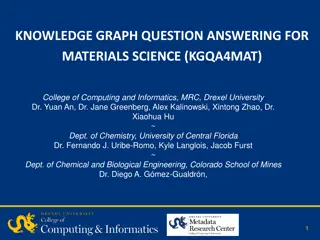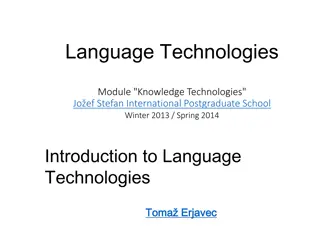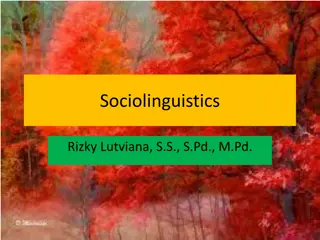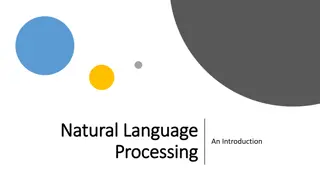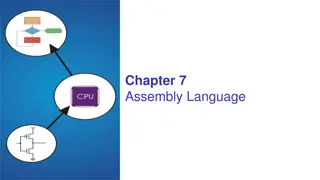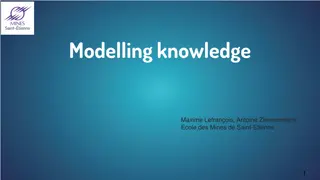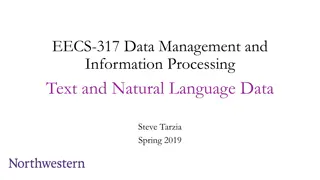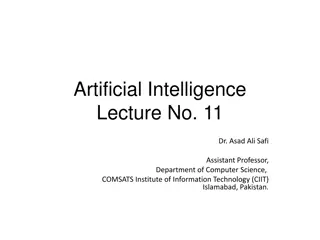Background Knowledge Role in Natural Language Understanding
This study delves into the importance of background knowledge in natural language understanding for information fusion, emphasizing how tractor architecture leverages knowledge of language use, the world, domain, and relations to interpret text effectively. Utilizing semantic analysis, the approach focuses on translating textual elements into formal knowledge representation, enabling accurate reasoning and information fusion from diverse sources like RADAR, SONAR, and LIDAR for comprehensive situation assessment.
Download Presentation

Please find below an Image/Link to download the presentation.
The content on the website is provided AS IS for your information and personal use only. It may not be sold, licensed, or shared on other websites without obtaining consent from the author.If you encounter any issues during the download, it is possible that the publisher has removed the file from their server.
You are allowed to download the files provided on this website for personal or commercial use, subject to the condition that they are used lawfully. All files are the property of their respective owners.
The content on the website is provided AS IS for your information and personal use only. It may not be sold, licensed, or shared on other websites without obtaining consent from the author.
E N D
Presentation Transcript
July, 2016 doc.: IEEE 802.11-16/0964r1 Considerations on MAC-PHY interactions during SR operations Date: 2016-07-28 Authors: Name Jing Ma Affiliations Address NICT Phone +81-46-847- 5444 email majing@nict.go.jp 3-4, Hikarino-oka, Yokosuka, 239- 0847, Japan ishidu@nict.go.jp Kentaro Ishizu NICT f-kojima@nict.go.jp Fumihide Kojima NICT Submission Slide 1 Jing Ma, NICT
July, 2016 doc.: IEEE 802.11-16/0964r1 Abstract So far, spatial reuse operation is specified in TGax draft D0.1[1] A STA should regard an inter-BSS PPDU with a valid PHY header and that has receiving power/RSSI below the OBSS PD level used by the receiving STA and that meets additional TBD conditions, as not having been received at all (e.g., should not update its NAV), except that the medium condition shall indicate BUSY during the period of time that is taken by the receiving STA to validate that the PPDU is from an inter-BSS, but not longer than the time indicated as the length of the PPDU payload. Some comments (CIDs 2665, 2719) are concerned with how to adjust the backoff counter during the spatial reuse operations. Comment resolutions should be carefully considered on the interactions between MAC and PHY layers for supporting SR operations. Submission Slide 2 Jing Ma, NICT
July, 2016 doc.: IEEE 802.11-16/0964r1 Proposal We agree with the commenters on elaborating the specific behaviors concerning backoff counter during the SR operations, and we propose that The baseline backoff procedure is maintained during the period of time that is taken by the receiving STA to validate the PPDU. When an inter-BSS PPDU arrives at a STA, The backoff procedure of that STA is suspended if the channel is indicated as BUSY at the beginning of preamble based on the legacy CS mechanism. Then, after receiving HE-SIG-A / MAC header successfully, If the channel is determined to be IDLE using SR-based CS mechanism (inter-BSS frame & the receive power < OBSS PD level) for the duration of an AIFS duration, then the backoff procedure is allowed to resumed. If the channel is determined to be BUSY using SR-based CS mechanism, the receiving process continues and the backoff procedure is still suspended. Submission Slide 3 Jing Ma, NICT
July, 2016 doc.: IEEE 802.11-16/0964r1 Proposal (cont d) Meanwhile it is also necessary to carefully consider the interaction of the backoff procedure with PHY and the interactions between MAC and PHY layers. We propose to define the interaction mechanisms between MAC and PHY layers for supporting SR operations. The details of the proposed solution are described in the following slides. Submission Slide 4 Jing Ma, NICT
July, 2016 doc.: IEEE 802.11-16/0964r1 Intra-BSS PPDU reception The MAC timing and PHY receive procedure of intra-BSS PPDU reception case is illustrated as follows The bakcoff procedure is suspended, that is the backoff timer shall not decrement for this slot The bakcoff procedure is resumed and the backoff timer shall decrement for this slot Medium busy AIFS Backoff slot AIFS Backoff slot PHY-RXEND.indication (NoError, RXVECTOR) PHY-DATA.indication PHY-DATA.indication PHY-DATA.indication PHY-CCA.indication PHY-RXSTART.indication (IDLE) PHY-CCA.indication PHY-CCA.indication (RXVECTOR) (BUSY) (IDLE) A-MPDU MAC PHY L- SIG RL- SIG PE Decoding delay DATA HE-SIG-A Measure RSSI 8 s 8 s 4 s 4 s 8 s L- SIG RL- SIG L-STF L-LTF PE DATA HE-SIG-A Submission Slide 5 Jing Ma, NICT Fig.1 Intra-BSS PPDU reception
July, 2016 doc.: IEEE 802.11-16/0964r1 Intra-BSS PPDU reception (cont d) The MAC timing and PHY receive procedure for intra-BSS frame reception case is the same as the baseline procedure[2]. a) When PHY detects the RX power is higher than CCA-SD at the beginning of the preamble, PHY issues PHY-CCA.indication (BUSY) primitive to indicate channel BUSY status to MAC. Then MAC suspends backoff procedure. b) After the PHY-CCA.indication (BUSY) primitive is issued, the PHY entity shall begin receiving the training symbols. Then after receiving valid L-SIG, RL-SIG and HE-SIG-A successfully, the PHY entity may issue a PHY-RXSTART.indication (RXVECTOR) primitive. c) Following training and signal fields, the Data field shall be received including a series of PHY- DATA.indication (DATA) primitive exchanges. d) After the reception of the final bit of the PPDU successfully, the PHY issues a PHY- RXEND.indication (NoError) primitive, then issues a PHY-CCA.indication (IDLE). e) The MAC is allowed to resume backoff procedure after determining that the channel remains IDLE for the duration of an AIFS. Submission Slide 6 Jing Ma, NICT
July, 2016 doc.: IEEE 802.11-16/0964r1 Inter-BSS PPDU reception According to the SR operation defined in TGax D0.1, the MAC timing and PHY receive procedure for inter-BSS PPDU reception case is illustrated as case A, B, and C respectively, and is not as in baseline. Case A: SR is allowed & RX power is lower than OBSS PD level Case B: SR is allowed & RX power is higher than OBSS PD level Case C: SR is not allowed Submission Slide 7 Jing Ma, NICT
July, 2016 doc.: IEEE 802.11-16/0964r1 Proposal on Case A Case A: SR is allowed & RX power is lower than OBSS PD level The bakcoff procedure is suspended, that is the backoff timer shall not decrement for this slot The bakcoff procedure is resumed and the backoff timer shall decrement for this slot Medium busy AIFS Backoff slot AIFS Backoff slot PHY-SR.request(OBSS PD Level) PHY-SR.confirm(IDLE) PHY-RXSTART.indication PHY-RXEND.indication PHY-CCA.indication PHY-CCA.indication (SR, RXVECTOR) (RXVECTOR) (BUSY) (IDLE) MAC PHY L- SIG RL- SIG PE Decoding delay DATA HE-SIG-A Measure RSSI 8 s 8 s 4 s 4 s 8 s L- SIG RL- SIG L-STF L-LTF PE DATA HE-SIG-A Submission Slide 8 Jing Ma, NICT Fig.2 Proposal on case A
July, 2016 doc.: IEEE 802.11-16/0964r1 Proposal on Case A (cont d) When SR is allowed and RX power is lower than OBSS PD level (We propose to define the interactions between PHY and MAC entities for supporting SR operation (the following c) ~ d) which are also shown in Fig.2 marked in blue)) a) When PHY detects the RX power is higher than CCA-SD at the beginning of the preamble, PHY issues PHY-CCA.indication (BUSY) primitive to indicate channel BUSY status to MAC. Then MAC suspends backoff procedure. b) After the PHY-CCA.indication (BUSY) primitive is issued, the PHY entity shall begin receiving the training symbols. Then after receiving valid L-SIG, RL-SIG and HE-SIG-A successfully, the PHY entity may issue a PHY-RXSTART.indication (RXVECTOR) primitive. c) Subsequently, if the BSS COLOR, SPATIAL REUSE within the RXVECTOR indicate the receiving PPDU is an inter-BSS PPDU and SR is allowed, then the MAC issues a PHY- SR.request (OBSS PD level) to request to the PHY entity to compare the OBSS PD level. d) Then the PHY compares the RX power with OBSS PD level. The PHY may issue a PHY- RXEND.indication (SR, RXVECTOR) primitive if RX power is lower than OBSS PD level. As well as, the PHY shall issue a PHY-SR.confirm (IDLE) to MAC entity. e) The MAC is allowed to resume backoff procedure after determining that the channel remains IDLE for the duration of a AIFS. Submission Slide 9 Jing Ma, NICT
July, 2016 doc.: IEEE 802.11-16/0964r1 Proposal on Case B Case B: SR is allowed & RX power is higher than OBSS PD level The bakcoff procedure is resumed and the backoff timer shall decrement for this slot The bakcoff procedure is suspended, that is the backoff timer shall not decrement for this slot AIFS Backoff slot AIFS Backoff slot Medium busy PHY-DATA.indication PHY-DATA.indication PHY-DATA.indication PHY-CCA.indication PHY-RXSTART.indication PHY-SR.confirm (BUSY) PHY-SR.request (IDLE) (OBSS PD level) PHY-CCA.indication (RXVECTOR) PHY-CCA.indication (BUSY) (IDLE) A-MPDU MAC PHY L- SIG RL- SIG Decoding delay PE DATA HE-SIG-A Measure RSSI 8 s 8 s 4 s 4 s 8 s L- SIG RL- SIG L-STF L-LTF PE DATA HE-SIG-A Fig.3 Proposal on case B Submission Slide 10 Jing Ma, NICT
July, 2016 doc.: IEEE 802.11-16/0964r1 Proposal on Case B (cont d) When SR transmission is allowed and RX power is higher than PD_level (We propose new interactions between PHY and MAC entities for supporting SR operation (the following c) ~ d) which are also shown in Fig.3 marked in blue)) a) When PHY detects the RX power is higher than CCA-SD at the beginning of the preamble, PHY issues PHY- CCA.indication (BUSY) primitive to indicate channel BUSY status to MAC. Then MAC suspends backoff procedure as shown in Fig.. b) After the PHY-CCA.indication (BUSY) primitive is issued, the PHY entity shall begin receiving the training symbols. Then after receiving valid L-SIG, RL-SIG and HE-SIG-A successfully, the PHY entity may issue a PHY-RXSTART.indication (RXVECTOR) primitive. c) Subsequently, if the BSS COLOR, SPATIAL REUSE within the RXVECTOR indicate the receiving PPDU is an inter-BSS PPDU and SR transmission is allowded, the MAC issues PHY-SR.request (OBSS PD level) to indicate PHY entity. d) Then the PHY compares the RX power with OBSS PD level. If RX power is higher than OBSS PD level, the PHY continues to receive the PPDU and issues a PHY-SR.confirm (BUSY) to MAC entity at the same time. e) After the reception of the final bit of the PPDU successfully, the PHY issues a PHY-RXEND.indication (NoError) primitive, then issues a PHY-CCA.indication (IDLE). f) The MAC is allowed to resume backoff procedure after determining that the channel remains IDLE for the duration of a AIFS. Submission Slide 11 Jing Ma, NICT
July, 2016 doc.: IEEE 802.11-16/0964r1 Proposal on Case C Case C: SR is not allowed The bakcoff procedure is suspended, that is the backoff timer shall not decrement for this slot The bakcoff procedure is resumed and the backoff timer shall decrement for this slot Medium busy AIFS Backoff slot AIFS Backoff slot PHY-RXEND.indication (NoError, RXVECTOR) PHY-DATA.indication PHY-DATA.indication PHY-DATA.indication PHY-CCA.indication PHY-RXSTART.indication (IDLE) PHY-CCA.indication (RXVECTOR) PHY-CCA.indication (BUSY) (IDLE) A-MPDU MAC PHY L- SIG RL- SIG PE Decoding delay DATA HE-SIG-A Measure RSSI 8 s 8 s 4 s 4 s 8 s L- SIG RL- SIG L-STF L-LTF PE DATA HE-SIG-A Fig.4 Proposal on case C Submission Slide 12 Jing Ma, NICT
July, 2016 doc.: IEEE 802.11-16/0964r1 Proposal on Case C (cont d) When SR transmission is not allowed a) When PHY detects the RX power is higher than CCA-SD at the beginning of the preamble, PHY issues PHY-CCA.indication (BUSY) primitive to indicate channel BUSY status to MAC. Then MAC suspends backoff procedure. b) After the PHY-CCA.indication (BUSY) primitive is issued, the PHY entity shall begin receiving the training symbols. Then after receiving valid L-SIG, RL-SIG and HE-SIG-A successfully, the PHY entity may issue a PHY-RXSTART.indication (RXVECTOR) primitive. c) Subsequently, if the BSS COLOR, SPATIAL REUSE within the RXVECTOR indicate the receiving PPDU is an inter-BSS PPDU but SR is NOT allowed, the PHY continues to receive the PPDU (as baseline CS). d) Following training and signal fields, the Data field shall be received including a series of PHY- DATA.indication (DATA) primitive exchanges. e) After the reception of the final bit of the PPDU successfully, the PHY issues a PHY- RXEND.indication (NoError) primitive, then issues a PHY-CCA.indication (IDLE). f) The MAC is allowed to resume backoff procedure after determining that the channel remains IDLE for the duration of a AIFS. Submission Slide 13 Jing Ma, NICT
July, 2016 doc.: IEEE 802.11-16/0964r1 Conclusion For intra-BSS frame reception, the MAC timing and PHY receive procedure is the same as the baseline procedure. For inter-BSS frame reception, the MAC timing and PHY receive procedure can be categories into three cases. Case A: SR is allowed & RX power is lower than OBSS PD level Case B: SR is allowed & RX power is higher than OBSS PD level Case C: SR is not allowed The proposed comment resolution is contained in 11-16/1025r0 Submission Slide 14 Jing Ma, NICT
July, 2016 doc.: IEEE 802.11-16/0964r1 References 1. 2. 11-16/0024r1, Draft Specifications, March 2016 Draft P802.11REVmc_D6.0 Submission Slide 15 Jing Ma, NICT
